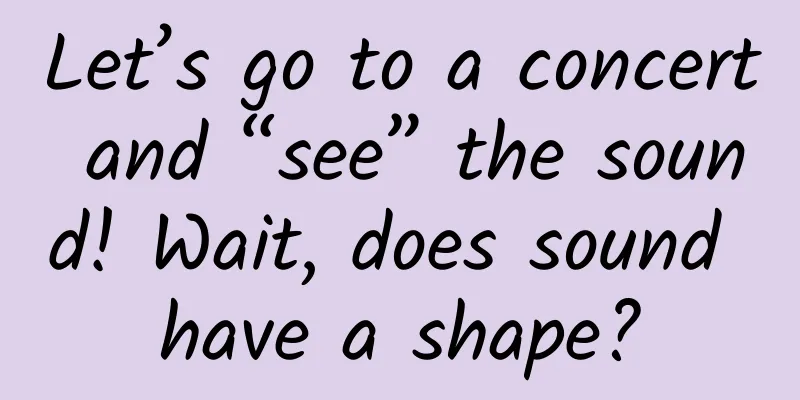Let’s go to a concert and “see” the sound! Wait, does sound have a shape?

|
What is the shape of sound? Imagine that you are at a concert. The lights around you gradually dim, and the spotlight shines on the violinist in the center of the stage. The audience is silent. She draws the bow across the strings, and beautiful notes flow out from the center, slowly filling the entire hall and also filling your heart. When you marvel at the beauty of the melodious violin sound, are you curious: Why does it take several months to modify and debug a seemingly ordinary violin? What is the mystery in this process? Don’t worry, once you get to know our protagonist today: Chladni figure, you will naturally have an answer to this question! 01 Nicola Graphics In the 18th century, German physicist Ernst Chladni conducted an experiment in which he placed a relatively wide metal sheet and evenly sprinkled sand on it, and then pulled it with a bowstring. As a result, the fine sand automatically arranged into different beautiful patterns, and as the rhythm of the bowstring continued to increase, the patterns also kept changing and becoming more complex - the famous Chladni figures. Ernst Chladni It is mysterious and you can never imagine what it will look like; it is extremely beautiful and always appears on the board in a way that is beyond people's imagination. It might look like this: Yes, these are real Chladni patterns! Seeing this, while marveling at the mystery and beauty of Chladni patterns, you must also be curious: what exactly commands these sands to automatically "arrange their troops" and jump out of beautiful patterns? 02Standing Wave Then we have to mention their "commander" - the magical "standing wave"! "Standing wave? Aren't you just having one wave after another?" Don't worry, let's take a look at the explanation on Baidu Encyclopedia: Standing waves refer to a distribution state formed along a transmission line by two waves (not necessarily radio waves) with the same frequency and opposite transmission directions. One of the waves is usually a reflection of the other. The antinodes appear at the points where the two voltages (or currents) are added, and the nodes are formed at the points where the two voltages (or currents) are subtracted. On the waveform, the positions of the nodes and antinodes are always constant, giving the impression of "standing still", but its instantaneous value changes with time. If the amplitudes of the two waves are equal, the amplitude of the nodes is zero. Are you a little dizzy? Let's take a look at a more intuitive picture: Right wave Wave to the left Two-wave synthesis Standing Wave It can be seen that the composite result after the two waves intersect is that the "wave node" does not move! As we know, sound waves are vibration waves that rely on objects to propagate. If there is a plate with sand on it, and the plate vibrates in the form of standing waves, there will be many "wave nodes" on it that do not vibrate. The sand that is not at the wave node position will continue to "jump" until it "jumps" to the wave node position and then stop changing. If the standing wave has a more colorful shape, then wouldn't the sand that gathers after "jumping together" also have a colorful shape! And this colorful pattern is the "Chladni pattern". Next please take a look at our Chladni Pattern Demonstrator setup! As the name suggests, a vibration generator is an instrument that generates vibrations continuously. It drives the rod to vibrate up and down, causing the vibration plate to propagate "sound waves" from the center, that is, vibration waves. The sound waves first propagate from the center to the outside along the plate. When the sound wave propagates to the edge of the board, it will be reflected back at the same frequency to form a reflected wave (when the sound wave propagates to the edge of the original material, if it still wants to propagate in the original direction, it must enter from one material into another material. At this time, part of the sound wave will be reflected. This is equivalent to the sound wave from the center entering the air from the board first and then being reflected back by the edge of the board). As mentioned in the previous introduction to standing waves: standing waves are composed of two waves with the same frequency and opposite transmission directions (one of the waves is generally the reflection of the other wave). Therefore, as long as we keep the vibration frequency of the vibration generator unchanged, we can generate standing waves on the board, and then sprinkle sand on it, and they will automatically jump into beautiful Chladni figures! This is the principle of our "Chladni figure demonstrator". 03Question Answer OK, now that we know about Chladni patterns, let’s go back to the original question: “Why does it take several months to tune a seemingly ordinary violin?” There is a reason that is closely related to our experiment: the outer shell of the violin is an important part of the sound, and the thickness and shape of the outer shell will greatly affect the vibration, thus affecting the sound quality of the entire violin. Just like the vibration plate in our device, if its shape or thickness changes, even if the vibration frequency is the same, the Chladni figure formed will be very different. In order to adjust the beautiful sound of the violin by carving the body, violin makers just borrowed the magical Chladni pattern: they used the outer shell of the violin as a "vibration plate", sprinkled sand on it, input a fixed frequency to make the outer shell vibrate, and observed the Chladni pattern formed to judge in real time whether the thickness and shape of the outer shell met the requirements of an "excellent violin". This repeated monitoring and grinding of the soundboard finally allowed the soundboard to vibrate and sound accurately. Speaking of abstraction, here are a few production drawings: The input backplane vibration frequencies are: 91Hz, 138Hz, 231Hz, 196Hz, 306Hz, 312Hz, 392Hz. Now you know why it takes ten years to sharpen the violin? In fact, Chladni figures are just one of the myriad ways we feel, appreciate, and use sound. There are many other wonderful phenomena and devices that allow us to "see sound". Let's explore them together! Contributors: Southwest University Popular Science Space Station, Chongqing Physics Society, Beibei District Science and Technology Association Audit expert: Zhang Qiaoming Statement: Except for original content and special notes, some pictures are from the Internet. They are not for commercial purposes and are only used as popular science materials. The copyright belongs to the original authors. If there is any infringement, please contact us to delete them. |
<<: Will a nap while lying on your stomach cause gastroptosis? The truth is...
>>: Is the ocean salty? This satellite tells you
Recommend
Lasting for more than 140 years and involving three generations of scientists, what exactly is this longest experiment in history studying?
Seeds are everywhere in our daily lives, from pea...
Why are the conversion rates of information flow accounts so poor?
Yesterday, I received a message like this in the ...
A guide and tips for Tik Tok account management for beginners!
Due to the recommendation mechanism of Douyin, th...
New trick to increase App user activity: free data flow
[[131188]] If you ask a person in charge of opera...
If you sleep an extra hour a day, what changes will you see in a year?
With the fast-paced life, insomnia has become a c...
The less bad cholesterol, the better, and the more good cholesterol, the better? In fact, this range is more appropriate!
With the popularization of health knowledge, many...
How to promote on Xiaohongshu? Xiaohongshu promotion tips!
In fact, most of the Xiaohongshu merchants are mo...
Why is it so difficult to start a business? Here are a few key points where you may fail
[[146094]] After several entrepreneurial teams su...
Samsung Galaxy S6 battery leak: capacity decreases instead of increases
Samsung's next flagship Galaxy S6 may have a ...
How to start Baidu information flow advertising from 0 to 1?
Baidu information flow was developed after Baidu ...
From music reviews to branded videos, what are NetEase Cloud Music’s marketing secrets?
There is a jargon in the advertising circle: NetE...
How do I implement offline caching of web pages step by step?
How to implement offline caching strategy for a h...
Loongson: A pure Chinese chip with a new lease of life
Speaking of chips, they have always been the focu...
Winter is dry, and your nose is scabbing and bleeding again? Don't panic, experts will teach you how to deal with it
In winter, the climate often becomes dry and cold...
SEO Practical Code 3rd Edition 60 Days to Increase Website Traffic 20 Times PDF Scan Download
The third edition of SEO Practical Code is a book...









